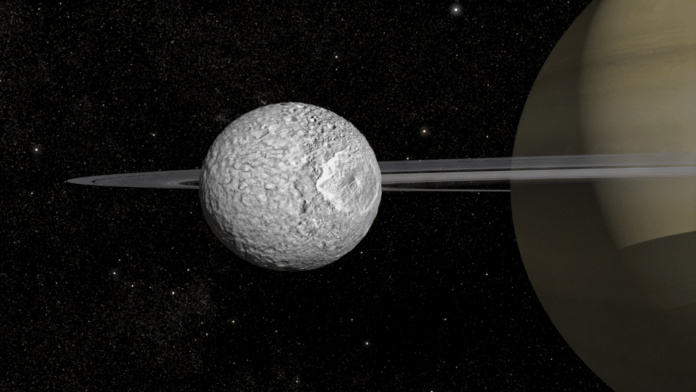
The Secrets of Mimas, Saturn’s Small Moon
Mimas, a petite moon of Saturn, conceals more than what meets the eye. Beneath its frozen, crater-dotted surface, it is believed to hide a liquid ocean.
The moon Mimas is just one of the 145 known satellites of Saturn. At first glance, it does not appear to be the most fascinating in the cluster. Its frozen surface gives it the look of a frigid, barren world. The enormous crater that dominates the moon’s terrain even gives it a resemblance to the Death Star from the Star Wars films. However, looks can be deceptive. Deep beneath the icy crust, a concealed ocean likely stoops. The ocean, hidden beneath a 20 to 30-kilometer-thick ice layer, plummets approximately 65 kilometers into the moon’s rocky core.
Two Theories
The conclusion was made by researchers after analyzing images from the Cassini space probe. By studying the rotation, orbit, position, distance, and motion of other celestial bodies, they could determine Mimas’ orbital motion with high precision. Next, the researchers studied the moon’s libration (oscillation around its rotation axis) and the precession of the moon (rotation of the moon’s orbit around its planet) – both are dependent on the moon’s core. Upon comparing the results with their hypotheses of either an elongated solid core or a global ocean, the ocean remained the only plausible explanation.
Mimas’ Young Ocean
While Mimas is not the only moon orbiting Saturn with a hidden ocean, it is – for now – the sole moon characterized by a crater-filled surface. Most other moons with oceans are fairly smooth; a trait exhibited by Enceladus. This is due to water from the underground ocean escaping through breaches in the ice shell and smoothing the surface. On Mimas, this process doesn’t occur; its surface is still, as mentioned, fraught with craters, including the massive crater that earned the moon the nickname ‘Death Star.’ Researchers surmise that this hints at Mimas’ ocean being quite young and hasn’t had enough time to permeate the ice shell and make its mark on the moon’s surface. Hence, it is entirely possible that the ocean may leave trails on the ice in the future, similar to moon Enceladus studies.
The Evolution
The study of Mimas gives us more insight into the array and evolution of icy worlds in our solar system. The liquid water present beneath the ice on Mimas suggests exciting possibilities for the development of extraterrestrial life, as speculated by researchers in a video released (embedded above) at the time of publication. “Its recent formation shows us that conditions favorable for the development of life could be present at any moment in the history of the solar system and beyond.”
The authors hope that their findings will lead to further research on Saturn’s medium-sized moons and those of other planets. One has to wonder, what other secrets might these celestial bodies hide beneath their icy crusts?











